Treat your book club to Leah Purcell's harrowing and timely retelling of Henry Lawson's The Drover's Wife.
Full of fury and power, Leah Purcell’s The Drover’s Wife: The Legend of Molly Johnson is a brave reimagining of the Henry Lawson short story that has become an Australian classic. At once an exploration of motherhood, bloodlines and family, colonialism and racism, misogyny and violence against women, the thematic layering provides plenty of brain food for a stimulating book club discussion. Get the conversation started with our questions below.
Discussion points and questions:
- Henry Lawson’s The Drover’s Wife was first published in 1892. What is it about this story that compels writers to continue to reimagine it in such a variety of styles and forms?
- Are you comfortable with the rewriting of well-known Australian stories? Do they add or detract from our national identity?
- Leah Purcell determinedly gave the eponymous drover’s wife a name, Molly Johnson, and moved it into the title of her story. Do you think this was an important act? How did it influence the story?
- Other aspects of Lawson’s life are drawn into Leah Purcell’s novel in the naming of Louisa Clintoff and her publication, Dawn. What do you think is the motivation behind this?
- Issues of race, gender, violence and inheritance are all present in this historical novel. Are they speaking to our past or our present? Why do you think we choose to read historical fiction?
- The Drover’s Wife: The Legend of Molly Johnson is told from a number of points of view, and different time periods. Did this style of storytelling work for you? Was there a perspective you preferred to others?
- Leah Purcell was in the high country, filming the Ray Lawrence film Lantana, when she first felt the urge to tell a story set there. She has created this novel and the film version of The Drover’s Wife: The Legend of Molly Johnson is in production, slated for release in 2020/21. How vital a part of the story is the landscape?
- Are you looking forward to the film?














